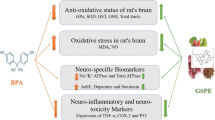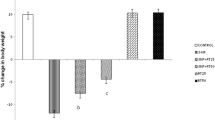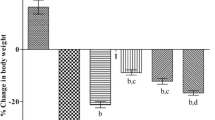Abstract
Introduction
The role of oxidative stress has been well known in neurodegenerative disorders. 3-Nitropropionic acid (3-NP) is a plant-based mycotoxin that produces HD like symptoms in animals. Oxidative stress and nitric oxide mechanisms have been recently proposed in the 3-NP-induced neurotoxicity. Epigallocatechin gallate (EGCG) is one of the major components of green tea, known for its potent antioxidant activity. Besides, neuroprotective effect of EGCG has also been suggested in different experimental models.
Objectives
The present study has been designed to examine possible effect of EGCG against 3-NP induced behavioral, oxidative stress, mitochondrial dysfunction, and striatal damage in rats and its possible interaction with nitric oxide modulators.
Material and methods
Systemic 3-NP (10 mg/kg) administration for 14 days significantly reduced locomotor activity, body weight, grip strength, oxidative defense (raised levels of lipid peroxidation, nitrite concentration, depletion of antioxidant enzyme), and mitochondrial enzymes activity in striatum, cortex, and hippocampal regions of the brain.
Results
Fourteen days of EGCG pretreatment (10, 20, and 40 mg/kg) significantly attenuated behavioral alterations, oxidative damage, mitochondrial complex enzymes dysfunction, and striatal damage in 3-NP-treated animals. l-arginine (50 mg/kg) pretreatment with sub-effective dose of EGCG (20 mg/kg) significantly reversed the protective behavioral, biochemical, cellular, and histological effects of EGCG. However, l-NAME (10 mg/kg) pretreatment with EGCG (20 mg/kg) significantly potentiated the protective effect of EGCG which was significant as compared to their effect per se.
Conclusion
The present study shows that EGCG attenuate 3-NP-induced neurotoxicity, and nitric oxide modulation might be involved in its protective action.









Similar content being viewed by others
References
Anderson RF, Fisher LJ, Hara Y, Harris T, Mak WB, Melton LD (2001) Green tea catechins partially protect DNA from (-) OH radical induced strand breaks and base damage through fast chemical repair of DNA radicals. Carcinogenesis 22:1189–1193
Arimoto-Kobayashi S, Inada N, Sato Y, Sugiyama C, Okamoto K, Hayatsu H, Negishi T (2003) Inhibitory effects of (-)-epigallocatechin gallate on the mutation, DNA strand cleavage, and DNA adduct formation by heterocyclic amines. J Agric Food Chem 51:5150–5153
Aucamp J, Gaspar A, Hara Y, Apostolides Z (1997) Inhibition of xanthine oxidase by catechins from tea (Camellia sinensis). Antican Res 17:4381–4386
Beal MF, Brouillet E, Jenkins BG, Ferrante RJ, Kowall NW, Miller JM, Storey E, Srivastava R, Rosen BR, Hyman BT (1993) Neurochemical and histologic characterization of striatal excitotoxic lesions produced by the mitochondrial toxin 3-nitropropionic acid. J Neurosci 13:4181–4192
Beal MF, Ferrante RJ, Henshaw R, Matthews RT, Chan PH, Kowall NW, Epstein CJ, Schulz JB (1995) 3-Nitropropionic acid neurotoxicity is attenuated in copper/zinc superoxide dismutase transgenic mice. J Neurochem 65:919–922
Berman SB, Hastings TG (1999) Dopamine oxidation alters mitochondrial respiration and induces permeability transition in brain mitochondria: implications for Parkinson’s disease. J Neurochem 73:1127–1137
Binienda Z, Simmons C, Hussain S, Slikker W Jr, Ali SF (1998) Effect of acute exposure to 3-nitropropionic acid on activities of endogenous antioxidants in the rat brain. Neurosci Lett 251:173–176
Brouillet E, Hantraye P (1995) Effects of chronic MPTP and 3-nitropropionic acid in nonhuman primates. Curr Opin Neurol 8:469–473
Burda J, Matiasová M, Gottlieb M, Danielisová V, Némethová M, Garcia L, Salinas M, Burda R (2005) Evidence for a role of second pathophysiological stress in prevention of delayed neuronal death in the hippocampal CA1 region. Neurochem Res 30:1397–1405
Büttemeyer R, Philipp AW, Schlenzka L, Mall JW, Beissenhirtz M, Lisdat F (2003) Epigallocatechin gallate can significantly decrease free oxygen radicals in the reperfusion injury in vivo. Transplant Proc 35:3116–3120
Chan MM, Fong D, Ho CT, Huang HI (1997) Inhibition of inducible nitric oxide synthase gene expression and enzyme activity by epigallocatechin gallate, a natural product from green tea. Biochem Pharmacol 54:1281–1286
Deshpande SB, Hida H, Takei-Io N, Masuda T, Baba H, Nishino H (2006) Involvement of nitric oxide in 3-nitropropionic acid-induced striatal toxicity in rats. Brain Res 1108:205–215
Devika PT, Stanely MPP (2008) (-) Epigallocatechin-gallate (EGCG) prevents mitochondrial damage in isoproterenol-induced cardiac toxicity in albino Wistar rats: a transmission electron microscopic and in vitro study. Pharmacol Res 57:351–357
Dykens JA (1994) Isolated cerebral and cerebellar mitochondria produce free radicals when exposed to elevated Ca and Na: implications for neurodegeneration. J Neurochem 63:584–591
Ehrnhoefer DE, Duennwald M, Markovic P, Wacker JL, Engemann S, Roark M, Legleiter J, Marsh JL, Thompson LM, Lindquist S, Muchowski PJ, Wanker EE (2006) Green tea (-)-epigallocatechin-gallate modulates early events in huntingtin misfolding and reduces toxicity in Huntington's disease models. Hum Mol Genet 15:2743–2751
El Massioui N, Ouary S, Cheruel F, Hantraye P, Brouillet E (2001) Perseverative behavior underlying attentional set-shifting deficits in rats chronically treated with the neurotoxin 3-nitropropionic acid. Exp Neurol 172:172–181
Etus V, Altug T, Belce A, Ceylan S (2003) Green tea polyphenol (-) - epigallocatechin gallate prevents oxidative damage on periventricular white matter of infantile rats with hydrocephalus. J Exp Med 200:203–209
Garcia E, Limon D, Perez-De La Cruz V, Giordano M, Diaz-Muñoz M, Maldonado PD, Herrera-Mundo MN, Pedraza-Chaverri J, Santamaria A (2008) Lipid peroxidation, mitochondrial dysfunction and neurochemical and behavioral deficits in different neurotoxic models: protective role of S-allylcysteine. Free Radic Res 42:892–902
Gornall AG, Bardawill CJ, David MM (1949) Determination of serum proteins by means of the biuret reaction. J Biol Chem 177:751–756
Green LC, Wagner DA, Glogowski J, Skipper PL, Wishnok JS, Tannebaum SR (1982) Analysis of nitrate, nitrite, and [15 N] nitrate in biological fluids. Ann Biochem 126:131–138
Guo Q, Zhao B, Li M, Shen S, Xin W (1996) Studies on protective mechanisms of four components of green tea polyphenols against lipid peroxidation in synaptosomes. Biochem Biophys Acta 1304:210–222
Karanian DA, Baude AS, Brown QB, Parsons CG, Bahr BA (2006) 3-Nitropropionic acid toxicity in hippocampus: protection through N-methyl-D-aspartate receptor antagonism. Hippocampus 16:834–42
Kelly MR, Geigerman CM, Loo G (2001) Epigallocatechin gallate protects U937 cells against nitric oxide-induced cell cycle arrest and apoptosis. J Cell Biochem 81:647–658
Kim JH, Kim S, Yoon IS, Lee JH, Jang BJ, Jeong SM, Lee BH, Han JS, Oh S, Kim HC, Park TK, Rhim H, Nah SY (2005) Protective effects of ginseng saponins on 3-nitropropionic acid-induced striatal degeneration in rats. Neuropharmacology 48:743–756
King TE (1967) Preparation of succinate dehydrogenase and reconstitution of succinate oxidase. Methods Enzymol 10:322–331
King TE, Howard RL (1967) Preparations and properties of soluble NADH dehydrogenases from cardiac muscle. Methods Enzymol 10:275–284
Klivenyi P, Andreassen OA, Ferrante RJ, Dedeoglu A, Mueller G, Lancelot E, Bogdanov M, Andersen JK, Jiang D, Beal MF (2000) Mice deficient in cellular glutathione peroxidase show increased vulnerability to malonate, 3-nitropropionic acid, and 1-methyl-4-phenyl- 1, 2, 5, 6-tetrahydropyridine. J Neurosci 20:1–7
Kono Y (1978) Generation of superoxide radical during auto-oxidation of hydroxylamine and an assay of superoxide dismutase. Arch Biochem Biophysics 186:189–195
Kulkarni SK (1999) Handbook of Experimental Pharmacology, 3rd Edition. Vallabh Parkashan, New Delhi, India
Kumar P, Kumar A (2009) Possible role of sertraline against 3-nitropropionic acid induced behavioral, oxidative stress and mitochondrial dysfunctions in rat brain. Prog Neuropsychopharmacol Biol Psychiatry 33:100–108
Kumar P, Padi SS, Naidu PS, Kumar A (2006) Effect of resveratrol on 3-nitropropionic acid-induced biochemical and behavioral changes: possible neuroprotective mechanisms. Behav Pharmacol 17:485–492
Kumar P, Padi SS, Naidu PS, Kumar A (2007) Cyclooxygenase inhibition attenuates 3-nitropropionic acid-induced neurotoxicity in rats: possible antioxidant mechanisms. Fundam Clin Pharmacol 21:297–306
La Fontaine M, Geddes J, Banks A, Butterfield DA (2000) Effect of exogenous and endogenous antioxidants on 3-nitropropionic acid induced oxidative stress and striatal lesions: insights into Huntington’s disease. J Neurochem 75:1709–1715
Lee SR, Kim SP, Kim JE (2000) Protective effect of topiramate against hippocampal neuronal damage after transient global ischemia in the gerbils. Neurosci Lett 281:184–187
Lin YL, Lin JK (1997) (-)-Epigallocatechin-3-gallate blocks the induction of nitric oxide synthase by down-regulating lipopolysaccharide-induced activity of transcription factor nuclear factor-kB. Mol Pharmacol 52:465–472
Liu Y, Peterson DA, Kimura H, Schubert D (1997) Mechanisms of cellular 3-(4, 5-dimethylthiazol-2-yl)-2, 5-diphenyltetrazolinium bromide (MTT) reduction. J Neurochem 69(2):581–593
Luck H (1971) Catalase. In: Bergmeyer HU (ed) Methods of enzymatic analysis. Academic, New York, pp 885–893
Ludolph AC, He F, Spencer PS, Hammerstad J, Sabri M (1991) 3-Nitropropionic acid-exogenous animal neurotoxin and possible human striatal toxin. Can J Neurol Sci 18:492–498
Mandel SA, Avramovich-Tirosh Y, Reznichenko L, Zheng H, Weinreb O, Amit T, Youdim MB (2005) Multifunctional activities of green tea catechins in neuroprotection. Modulation of cell survival genes, iron-dependent oxidative stress and PKC signaling pathway. Neurosignals 14:46–60
Matsuo N, Yamada K, Shoji K, Mori M, Sugano M (1997) Effect of tea polyphenols on histamine release from rat basophilic leukemia (RBL-2H3) cells: the structure-inhibitory activity relationship. Allergy 52:58–64
Matthews RT, Yang L, Jenkins BG, Ferrante RJ, Rosen BR, Kaddurah-Daouk R, Beal MF (2000) Neuroprotective effects of creatine and cyclocreatine in animal models of Huntington’s disease. J Neurosci 18:156–163
Moncada S, Palmer RMJ, Higgs DA (1992) Nitric oxide: physiology, pathophysiology and pharmacology. Pharmacol Rev 43:109–142
Morley N, Clifford T, Salter L, Campbell S, Gould D, Curnow A (2005) The green tea polyphenol (-)-epigallocatechin gallate and green tea can protect human cellular DNA from ultraviolet and visible radiation-induced damage. Photodermatol Photoimmunol Photomed 21:15–22
Nagai K, Jiang MH, Hada J, Nagata T, Yajima Y, Yamamoto S, Nishizaki T (2002) (-)-Epigallocatechin gallate protects against NO stress induced neuronal damage after ischemia by acting as an anti-oxidant. Brain Res 956:319–322
Nam E, Lee SM, Koh SE, Joo WS, Maeng S, Im HI, Kim YS (2005) Melatonin protects against neuronal damage induced by 3-nitropropionic acid in rat striatum. Brain Res 1046:90–96
Paquay JB, Haenen GR, Stender G, Wiseman SA, Tijburg LB, Bast A (2000) Protection against nitric oxide toxicity by tea. J Agric Food Chem 48:5768–5772
Pérez-De La Cruz V, Elinos-Calderón D, Robledo-Arratia Y, Medina-Campos ON, Pedraza-Chaverrí J, Ali SF, Santamaría A (2009) Targeting oxidative/nitrergic stress ameliorates motor impairment, and attenuates synaptic mitochondrial dysfunction and lipid peroxidation in two models of Huntington's disease. Behav Brain Res 199:210–217
Picconi B, Passino E, Sgobio C, Bonsi P, Barone I, Ghiglieri V, Pisani A, Bernardi G, Ammassari-Teule M, Calabresi P (2006) Plastic and behavioral abnormalities in experimental Huntington’s disease: a crucial role for cholinergic interneurons. Neurobiol Dis 22:143–152
Rezai-Zadeh K, Arendash GW, Hou H, Fernandez F, Jensen M, Runfeldt M, Shytle RD, Tan J (2008) Green tea epigallocatechin-3-gallate (EGCG) reduces beta-amyloid mediated cognitive impairment and modulates tau pathology in Alzheimer transgenic mice. Brain Res 1214:177–187
Rodríguez-Martínez E, Rugerio-Vargas C, Rodríguez AI, Borgonio-Pérez G, Rivas-Arancibia S (2004) Antioxidant effects of taurine, vitamin C, and vitamin E on oxidative damage in hippocampus caused by the administration of 3-nitropropionic acid in rats. Int J Neurosci 114:1133–1145
Saydoff JA, Liu LS, Garcia RA, Hu Z, Li D, von Borstel RW (2003) Oral uridine pro-drug PN401 decreases neurodegeneration, behavioral impairment, weight loss and mortality in the 3-nitropropionic acid mitochondrial toxin model of Huntington’s disease. Brain Res 994:44–54
Silva RH, Abílio VC, Kameda SR, Takatsu-Coleman AL, Carvalho RC, Ribeiro Rde A, Tufik S, Frussa-Filho R (2007) Effects of 3-nitropropionic acid administration on memory and hippocampal lipid peroxidation in sleep-deprived mice. Prog Neuropsychopharmacol Biol Psychiatry 31:65–70
Sottocasa GL, Kuylenstierna B, Ernster L, Bergstrand A (1967) An electron-transport system associated with the outer membrane of liver mitochondria. A biochemical and morphological study. J Cell Biol 32:415–428
Suganuma M, Okabe S, Oniyama M, Tada Y, Ito H, Fujiki H (1998) Wide distribution of [3H] (-)-epigallocatechin gallate, a cancer preventive tea polyphenol, in mouse tissue. Carcinogenesis 19:1771–1776
Sutherland BA, Shaw OM, Clarkson AN, Jackson DN, Sammut IA, Appleton I (2005) Neuroprotective effects of (-)-epigallocatechin gallate following hypoxia–ischemia-induced brain damage: novel mechanisms of action. Faseb J 19:258–260
Tedeschi E, Menegazzi M, Yao Y, Suzuki H, Forstermann U, Kleinert H (2004) Green tea inhibits human inducible nitric-oxide synthase expression by down-regulating signal transducer and activator of transcription-1alpha activation. Mol Pharmacol 65:111–120
Túnez I, Santamaría A (2009) Model of Huntington’s disease induced with 3-nitropropionic acid. Rev Neurol 48:430–434
Túnez I, Montilla P, del Carmen Muñoz M, Medina FJ, Drucker-Colín R (2006) Effect of transcranial magnetic stimulation on oxidative stress induced by 3-nitropropionic acid in cortical synaptosomes. Neurosci Res 56:91–95
Túnez I, Feijóo M, Collado JA, Medina FJ, Peña J, Muñoz Mdel C, Jimena I, Franco F, Rueda I, Muntané J, Montilla P (2007) Effect of testosterone on oxidative stress and cell damage induced by 3-nitropropionic acid in striatum of ovariectomized rats. Life Sci 80:1221–1227
Turan N, Csonka C, Csont T, Giricz Z, Fodor G, Bencsik P, Gyöngyösi M, Cakici I, Ferdinandy P (2006) The role of peroxynitrite in chemical preconditioning with 3-nitropropionic acid in rat hearts. Cardiovasc Res 70:384–390
Unno K, Takabayashi F, Oku N (2004) Improvement in brain function and oxidative damage of aged senescence-accelerated mice by green tea catechins. Intl Congress Series 1260:409–412
Wei IH, Wu YC, Wen CY, Shieh JY (2004) Green tea polyphenol (-) - epigallocatechin gallate attenuates the neuronal NADPH-d/nNOS expression in the nodose ganglion of acute hypoxic rats. Brain Res 999:73–80
Wills ED (1966) Mechanism of lipid peroxide formation in animal. Biochem J 99:667–676
Xie D, Liu G, Zhu G, Wu W, Ge S (2004) (-)-Epigallocatechin-3-gallate protects cultured spiral ganglion cells from H2O2-induced oxidizing damage. Acta Otolaryngol 124:464–470
Yang L, Calingasan NY, Chen J, Ley JJ, Becker DA, Beal MF (2005) A novel azulenyl nitrone antioxidant protects against MPTP and 3-nitropropionic acid neurotoxicities. Exp Neurol 191:86–93
Zeevalk GD, Derr-Yellin E, Nicklas WJ (1995) NMDA receptor involvement in toxicity to dopamine neurons in vitro caused by the succinate dehydrogenase inhibitor 3-nitropropionic acid. J Neurochem 64:455–458
Zhao B, Guo Q, Xin W (2001) Free radical scavenging by green tea polyphenols. Methods Enzymol 335:217–231
Acknowledgment
Authors gratefully acknowledged the financial support of Indian Council of Medical Research (ICMR), New Delhi for carrying out this work. The Senior Research Fellowship (Puneet Kumar) of the Indian Council of Medical Research (ICMR), New Delhi, is gratefully acknowledged.
Author information
Authors and Affiliations
Corresponding author
Rights and permissions
About this article
Cite this article
Kumar, P., Kumar, A. Protective effects of epigallocatechin gallate following 3-nitropropionic acid-induced brain damage: possible nitric oxide mechanisms. Psychopharmacology 207, 257–270 (2009). https://doi.org/10.1007/s00213-009-1652-y
Received:
Accepted:
Published:
Issue Date:
DOI: https://doi.org/10.1007/s00213-009-1652-y




